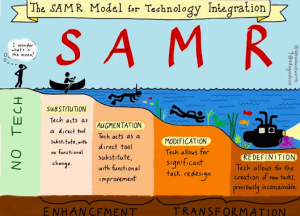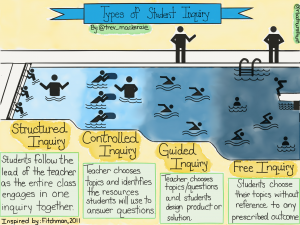Hamilton, Rosenburg, Akcaoglu, reviewed the Substitution Augmentation Modification Redefinition (SAMR) model and wrote suggestions for its use. However, the first questions that came to mind as I read this article were: why do I need to evaluate how I am using technology in the classroom, what is the purpose of this model?
It seems that the main purpose is to look at the technology used in the classroom, classify it under one of the four headings, and then review how the teacher uses technology. Once the information is classified, the teacher can use the information to perhaps try to use technology in an improved way (ex. moving a lesson from the Augmentation stage to the Modification stage). Connecting this to the TPACK Model, which looks at teacher’s technology skills as well at their pedagogical knowledge and teaching ability, is also used to better inform teaching.
All teachers should, if they don’t regularly, reflect on their teaching practices, evaluate the tools they are using, and make improvements as necessary.
After evaluating my own classroom, I came to the conclusion that the majority of my technology use falls under the substitution heading. Is this a bad thing? Should I be trying to move my students toward Redefinition? I don’t think so. My job as a K/1 teacher is to provide instruction and build the foundation in which the students will build their knowledge from for the rest of their life. I believe that students need to have the skills to use the technology available to them before they can begin to experiment with it.
For example, my child in grade three has been talking about building a robot for 3 years. He can’t just jump in and start building a robot. Hence why he is still talking about it! He has many skills to learn: math, circuits, computer language, welding, etc. before he can put all those pieces together to create his robot. It starts with the bare bone basics.
As a teacher, I am modelling the use of technology, which in time, builds their prior knowledge to create new things. I select specific tools, evaluating them, based on the learning outcomes I have. Reading the Meyer article, provided some great insights into how students learn with digital materials. I will use this information to further gauge the value of the digital tool I am using with my students in order to provide the most optimal learning environment.
While reading the Hamilton, et al, article, I was struck by how two images seemed very familiar to me.

Drawn by Sylvia Duckworth

Created by Jaclyn Stevens
This is the image that they reminded me of:

From Trevor Mackenzie’s Book Dive into Inquiry
Like the SAMR swimming pool analogy, inquiry-based learning involves the process of beginning together, testing the waters but still together, trying a bit on your own but with supports, and then doing it independently. All of this is dependent on the student’s abilities and skills which returns us to the basics. Teachers continually are swimming laps, trying new things, and building on.
Like any tool teachers are introduced to, we must evaluate the effectiveness of that tool before investing our time and energy into it. While I appreciate the benefits of this tool, I agree with the authors of the article, it is missing context, has a rigid structure, and the product verses process dilemma. I also feel that this is not relevant to the specific grade I am teaching at this time. If I was to teach middle school or high school, perhaps I could use it, but again, I am most often looking for the learning process instead of the product.
As I grow as an educator, I will continue to evaluate tools and technology making sure there is a purpose to the technology , whether it be to introduce students to the tool of technology or to build their knowledge using technology.
Mayer, R. E. (2017). Using multimedia for e‐learning. Journal of Computer Assisted Learning, 33(5), 403-423.


Recent Comments